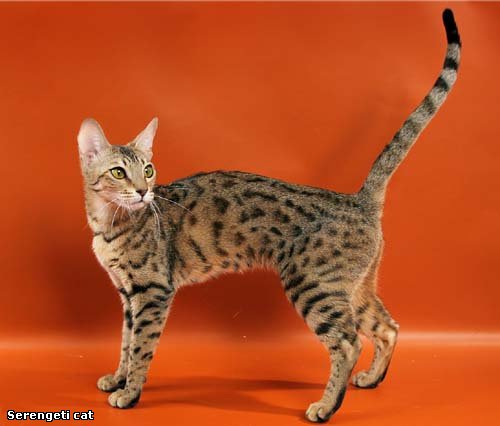The Serengeti cat, with its striking appearance and engaging personality, is a relatively new breed that has quickly gained popularity among cat enthusiasts. Developed with the intention of mimicking the wild African serval’s beauty without incorporating any wild blood, this breed offers a unique blend of elegance and domesticity. This guide will delve into the Serengeti cat’s history, physical characteristics, personality traits, health considerations, and care requirements, providing a comprehensive overview for potential owners and feline aficionados alike.
History of the Serengeti Cat
The Serengeti cat’s journey began in the mid-1990s, thanks to the efforts of conservation biologist Karen Sausman. Sausman, who owned the Kingsmark Cattery in California, aimed to create a cat that resembled the African serval but was entirely domestic. She achieved this by crossing Bengal cats, known for their wild looks and playful nature, with Oriental Shorthairs, renowned for their sleek bodies and vocal personalities. The result was the Serengeti cat, a breed that combines the best of both worlds.
Unlike the Savannah cat, which also aims to emulate the serval’s appearance but includes actual serval blood, the Serengeti is purely a domestic breed. This distinction is crucial for pet owners who desire an exotic-looking cat without the challenges associated with owning a part-wild animal. Since its inception, the Serengeti breed has been recognized by The International Cat Association (TICA) as a preliminary new breed and continues to grow in popularity.
Physical Characteristics
The Serengeti cat is medium-sized, with a muscular and agile build. One of its most distinctive features is its long legs, which give it an elegant and statuesque appearance. This breed also boasts a long neck that seamlessly blends into its head, which is topped with exceptionally large, round-tipped ears—a trait that enhances its wild look.
The Serengeti’s coat is short, silky, and dense, adding to its allure. The breed comes in several color variations, including:
- Yellow to gold with black spots
- Solid black
- Grey with black spots
- Bright silver with black spots
These spots are usually widely spaced, contributing to the cat’s striking appearance. The eyes of the Serengeti are another notable feature; they are large, round, and typically gold to amber, although hazel to light green eyes are also acceptable under TICA standards.
Personality and Temperament
Serengeti cats are known for their friendly and confident nature. They may appear shy when introduced to new environments or people, but they quickly warm up and become affectionate companions. These cats are highly active and agile, often found perched in high places or racing through the house with incredible speed.
Their playful nature is balanced by their affectionate disposition. Serengeti cats enjoy interacting with their human families and are known for their loyalty. They are also quite vocal, a trait inherited from their Oriental Shorthair ancestors, and they enjoy “conversing” with their owners. This breed’s vocalization is not as loud as some other breeds, making them a pleasant companion for those who enjoy a chatty cat.
Serengeti cats generally get along well with other pets when properly introduced. Their social nature makes them a great addition to households with other cats or even dogs, provided the introductions are handled carefully.
Health and Lifespan
The Serengeti cat is generally a healthy breed with no specific health issues associated with it. With proper care, Serengeti cats can live well into their mid-teens. Regular veterinary check-ups, vaccinations, and a balanced diet are essential to maintain their health and well-being.
Like all cats, Serengetis should receive annual vaccinations to protect against common feline diseases such as flu, enteritis, and feline leukemia, especially if they go outdoors. Regular parasite control is also important, as is maintaining a healthy weight to avoid obesity-related issues.
Given their Bengal heritage, Serengeti cats may exhibit strong hunting instincts. If allowed outside, they might bring home small animals as trophies. Owners should be mindful of this behavior and consider whether it aligns with their living situation and local wildlife conservation efforts.
Grooming and Care
Caring for a Serengeti cat is relatively straightforward due to their short, sleek coat, which requires minimal grooming. Regular brushing helps to remove loose hairs and reduce shedding. Additionally, grooming sessions provide an excellent opportunity for bonding with your cat.
When it comes to feeding, Serengeti cats do well on a high-quality commercial cat food. It’s important to provide a balanced diet that meets their nutritional needs. Treats like cooked meat or grated cheese can be given occasionally, but cow’s milk should be avoided as it can cause stomach upset.
Ensuring that fresh water is always available is crucial for keeping your Serengeti hydrated. Regular dental care, including brushing their teeth and providing dental treats, can help maintain oral health and prevent dental diseases.
Exercise and Enrichment
Serengeti cats are highly active and require ample opportunities for exercise and enrichment. Providing a variety of toys, climbing structures, and interactive play sessions can help keep them mentally and physically stimulated. Scratching posts are also essential to satisfy their natural scratching instincts and keep their claws healthy.
Interactive toys, such as puzzle feeders and laser pointers, can engage their hunting instincts and provide much-needed mental stimulation. Additionally, creating vertical spaces with cat trees or shelves allows Serengeti cats to climb and explore, satisfying their love for heights.
Living Environment
While Serengeti cats adapt well to indoor living, they need plenty of space to move around due to their active nature. A safe and stimulating environment is key to keeping them happy and healthy. If you have a secure outdoor space, such as a catio or enclosed garden, your Serengeti can enjoy some outdoor time safely.
Owners should be aware that Serengeti cats can be quite vocal, and their meows might become more frequent if they feel bored or neglected. Regular interaction and playtime are essential to prevent behavioral issues and ensure a happy, well-adjusted cat.
Conclusion
The Serengeti cat is a fascinating breed that offers a unique blend of wild beauty and domestic charm. Their striking appearance, combined with their friendly and active nature, makes them a wonderful choice for families and individuals seeking a loyal and engaging feline companion. With proper care, Serengeti cats can lead long, healthy, and fulfilling lives, bringing joy and companionship to their owners.
Whether you are drawn to their exotic looks or their playful personality, the Serengeti cat is a breed that is sure to captivate and delight. By understanding their history, traits, and care requirements, you can provide the best possible home for your Serengeti and enjoy a rewarding relationship with this extraordinary breed.

